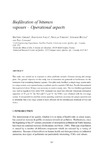Mostrar o rexistro simple do ítem
Biofiltration of bitumen vapours - Operational aspects
| dc.contributor.author | Girard, Matthieu | es_ES |
| dc.contributor.author | Fanlo, Jean-Louis | es_ES |
| dc.contributor.author | Turgeon, Nicolas | es_ES |
| dc.contributor.author | Buelna, Gerardo | es_ES |
| dc.contributor.author | Lessard, Paul | es_ES |
| dc.date.accessioned | 2014-10-01T10:17:06Z | |
| dc.date.available | 2014-10-01T10:17:06Z | |
| dc.date.issued | 2007 | es_ES |
| dc.identifier.citation | Biotechniques for Air Pollution Control II, 2007: 587-595. ISBN: 978-84-9749-258-4 | es_ES |
| dc.identifier.isbn | 978-84-9749-258-4 | es_ES |
| dc.identifier.uri | http://hdl.handle.net/2183/12856 | |
| dc.description.abstract | [Abstract] This study was carried out in response to odour problems around a bitumen mixing and storage plant. The general objective of this study was to determine the potential of biofiltration for the treatment of air containing bitumen vapours. Two pilot-scale biofilters, a single-stage system and a two-stage system, were operated using a synthetic gas for a period of 106 days. Results demonstrated that a period of about 50 days was necessary to reach a steady state. The two biofilters performed very well in regards to H2S, while VOC treatment was much less efficient. Maximum elimination capacities of 25 g·m-3·h-1 for H2S and 5.3 g·m-3·h-1 for VOCs were obtained with the two-stage system. It was possible to establish certain operating conditions necessary for proper operation and to determine that a two-stage system is more efficient for the simultaneous treatment of H2S and VOCs. | es_ES |
| dc.language.iso | eng | es_ES |
| dc.publisher | Universidade da Coruña | es_ES |
| dc.title | Biofiltration of bitumen vapours - Operational aspects | es_ES |
| dc.type | info:eu-repo/semantics/conferenceObject | es_ES |
| dc.rights.access | info:eu-repo/semantics/openAccess | es_ES |






